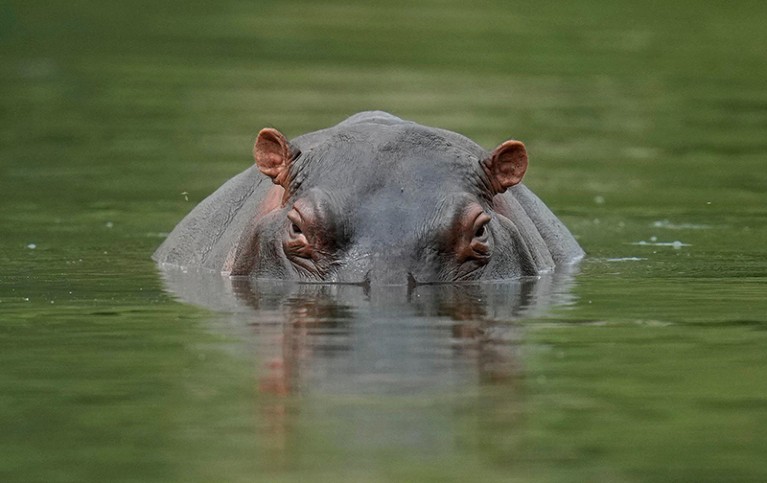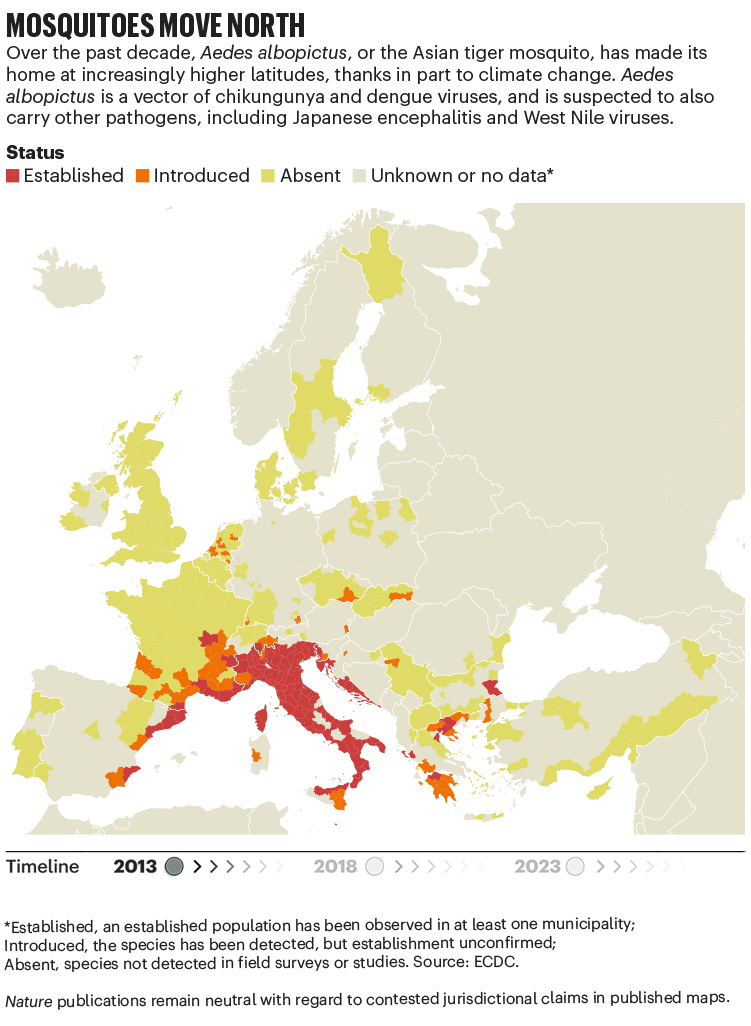Hello Nature readers, would you like to get this Briefing in your inbox free every day? Sign up here.

Wild hippos spend most of the day immersed in water and can be difficult to capture.Credit: Fernando Vergara/AP Photo/Alamy
Colombia has started sterilizing its population of invasive hippos — thought to number around 200 — that are overrunning the nation’s riverside habitats. The hippos (Hippopotamus amphibius) are the descendants of four illegally imported individuals that escaped from drug-cartel leader Pablo Escobar’s estate in the 1990s. Ecologists warn that sterilization is expensive and logistically challenging — and probably won’t be enough. Many researchers advocate culling the hippos, which the government says it will also try to do — but the idea is controversial.
Nature | 6 min read
Artificial intelligence (AI) tools designed to spot signs of Alzheimer’s disease in brain scans could help researchers to investigate treatments for the disease. There are databases containing thousands of people’s genomes and brain scans, but it’s hard to be sure which of those people have Alzheimer’s. There’s no foolproof blood test, and dementia is also a feature of other disorders. One of the new algorithms detects Alzheimer’s with an accuracy of more than 90%, and scientists hope to train another to identify structural features that differ between brain scans of people with and without the disease. The goal is to use brain images as visual ‘biomarkers’ of Alzheimer’s disease.
Nature | 5 min read
References: bioRxiv preprint & medRxiv preprint (not peer reviewed)
Four prominent research groups showed that the replication crisis in experimental psychology can be turned around by using the most rigorous and careful experimental conditions. By sticking to best practices such as ‘preregistration’ — the publication of a research plan in advance — the researchers produced results that were replicable 86% of the time, even better than could be expected on the basis of the sizes of the samples and the observed effects. The study, the authors say, shows that research in the field can be top quality if all the right steps are taken.
Nature | 4 min read
Reference: Nature Human Behaviour paper
Features & opinion
Table of Contents
India’s capital has been blanketed by choking smog since the beginning of November. But the situation is not unusual. Every year, the cooler, drier weather of the post-monsoon season provides ideal conditions for pollution to spike. The atmosphere’s lowest layer, the troposphere, shrinks at this time, and the soup of pollutants within it becomes more concentrated. Windless days exacerbate the problem. Although crop burning in neighbouring regions is often blamed for the pollution, locally produced emissions from traffic and woodfired stoves and heaters are enough to create a toxic cocktail.
Nature | 4 min read
Universities are starting quantum-training programmes at the bachelor’s and master’s levels to feed the burgeoning quantum-technology industry. “A technology can’t succeed if the only people who know how to use it are PhDs,” says physicist Olivia Lanes, who works at IBM.
Nature | 9 min read
A drastic crash in the Bering Sea’s population of snow crabs (Chionoecetes opilio) — a loss of some 10 billion crabs — might have been caused, in part, by marine heatwaves that increased the crabs’ metabolisms until they starved. “You heat up a crab or anything else, everything gets faster, up to a certain point when it can’t handle it anymore,” says evolutionary biologist Carolyn Tepolt. “It’s what happens when you increase that need for energy, essentially, beyond the point that the environment can provide it.”
Wired | 7 min read
Reference: Science paper
Infographic of the week

Climate change, international trade and travel are bringing the vectors of debilitating and sometimes deadly pathogens to Europe. And other parts of the non-tropical world that have previously had the luxury of not worrying about neglected tropical diseases — including the Gulf Coast of the United States — are experiencing similar issues. (Nature | 11 min read)
This article is part of Nature Outlook: Neglected tropical diseases, an editorially independent supplement funded by a grant from Merck Sharp & Dohme and with financial support from Moderna. (Source: ECDC. Nature publications remain neutral with regard to contested jurisdictional claims in published maps.)
On Friday, Leif Penguinson was exploring Hohe Tauern National Park in Austria — the largest national park in Central Europe. Did you find the penguin? When you’re ready, here’s the answer.
Thanks for reading,
Flora Graham, senior editor, Nature Briefing
With contributions by Katrina Krämer and Dyani Lewis
Want more? Sign up to our other free Nature Briefing newsletters:
• Nature Briefing: Cancer — a weekly newsletter written with cancer researchers in mind
• Nature Briefing: Translational Research covers biotechnology, drug discovery and pharma
• Nature Briefing: Anthropocene — the footprint of humanity on Earth, including climate change, biodiversity, sustainability and geoengineering
• Coming soon: Nature Briefing: AI & Robotics — the use of artificial intelligence and robotics in science, and their impact on how science is done — 100% written by humans, of course
